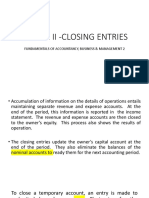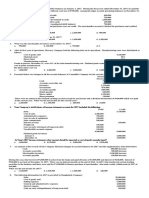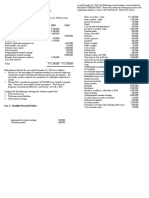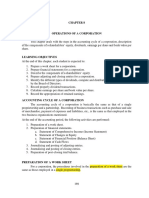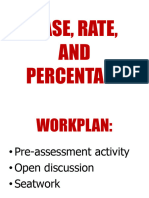Professional Documents
Culture Documents
FABM 2 Closing-Entries 1
FABM 2 Closing-Entries 1
Uploaded by
ariannekaryllemercadoOriginal Description:
Original Title
Copyright
Available Formats
Share this document
Did you find this document useful?
Is this content inappropriate?
Report this DocumentCopyright:
Available Formats
FABM 2 Closing-Entries 1
FABM 2 Closing-Entries 1
Uploaded by
ariannekaryllemercadoCopyright:
Available Formats
Living Angels Christian Academy
SY 2021-2022
FUNDAMENTALS OF ACCOUNTANCY, BUSINESS AND MANAGEMENT 2
COMPLETING THE ACCOUNTING CYCLE
Closing Entries
Accumulation of information on the details of operations entails maintaining separate revenue
and expense accounts. At the end of the period, this information is reported in the income
statement. The revenue and expense accounts are then closed to the owner’s equity. This
process also shows the results of operation. The closing entries update the owner’s capital
account at the end of the period. They also eliminate the balances of the nominal accounts to
ready them for the next accounting period.
To close a temporary account, an entry is made to make its balance become zero. Closing
transfers the balances of the temporary accounts to the capital account. The Income Summary,
considered to be a summary account, is used to close the income and expense accounts.
For illustrations purposes, assume that the following are the ledger balances of Anime World
Gallery after adjustment. Prepare the closing entries.
Anime World Gallery
Trial Balance
May 31, 2016
Cash Php 373,660
Accounts Receivable 70,000
Allowance for Bad Debts Php 1,500
Art Supplies 5,400
Prepaid Rent 6,000
Prepaid Insurance 8,100
Office Equipment 180,000
Accumulated Depreciation- Office Equipment 5,000
Furniture and Fixture 40,000
Accumulated Depreciation – Furniture and Fixture 1,000
Accounts Payable 32,200
Notes Payable 100,000
Utilities Payable 4,500
Unearned Painting Revenue 80,000
Ong, Capital 300,000
Ong, Drawing 18,000
Painting Revenue 210,000
Salaries Expense 4,000
Utilities Expense 5,040
Insurance Expense 2,700
Rent Expense 12,000
Art Supplies Expense 1,800
Depreciation Expense 6,000
Bad Debts Expense 1,500
Php 734,200 Php 734,200
Steps in Closing the Accounts
1. Close the income accounts
Since income accounts have normal credit balances, each revenue account will have to
be debited in the amount of its balance to bring their balances to zero. The credit is made to the
income summary account.
2016
May 31 Painting Revenue 210,000
Income Summary 210,000
To close income accounts.
2. Close the expense accounts
Expense accounts have normal debit balances, each of these will have to be credited to
close the account. Thus, a compound entry is needed considering the number of expense
accounts. The total of all expense accounts is then debited to income summary. The entry to
close the expense accounts of Anime World Gallery:
May 31 Income Summary 33,040
Salaries Expense 4,000
Utilities Expense 5,040
Insurance Expense 2,700
Rent Expense 12,000
Art Supplies Expense 1,800
Depreciation Expense 6,000
Bad Debts Expense 1,500
To close expense accounts
3. Close the income summary to capital
Notice that after posting the entries involving the income and expense accounts, the
balance of the income summary account is exactly the net income or net loss for the period. A
credit balance indicates net income and a debit balance indicates a net loss. Regardless of
whether the business yields a net income or a net loss, the income summary account must be
closed to the capital account. For Anime World Gallery, the entry is:
May 31 Income Summary 176,960
Ong, Capital 176,960
To close the income summary to capital
Note: The balancing figure of the income summary account is to be closed to capital is the net
income or net loss of the business. In the case of Anime World Gallery, Php 176,960 is the amount
of net income.
4. Close the drawing account
The drawing account represents the amount withdrawn by the owner either in cash or
non-cash assets for personal use. It is for this reason that the debit balance of the drawing
account should be closed to capital. The following entry is an illustration using Anime World
Gallery:
May 31 Ong, Capital 18,000
Ong, Drawing 18,000
To close drawing account to capital
Ong, Flocer Lao (2016). Fundamentals of Accountancy, Business, and Management. Quezon City: C&E Publishing, Inc.
You might also like
- Soal Bahasa Inggris Kelas 1 Semester 2 Kurikulum MerdekaDocument3 pagesSoal Bahasa Inggris Kelas 1 Semester 2 Kurikulum MerdekaTalya Wijaya100% (8)
- Drilling Machine ChecklistDocument1 pageDrilling Machine ChecklistRabbanNo ratings yet
- Closing and Post-Closing EntriesDocument13 pagesClosing and Post-Closing EntriesBrian Reyes GangcaNo ratings yet
- Closing EntriesDocument23 pagesClosing EntriesLeonabelle Yago DawitNo ratings yet
- Lesson 2 - Closing EntriesDocument10 pagesLesson 2 - Closing EntriesJannah FrancineNo ratings yet
- Problem #1: Adjusting EntriesDocument5 pagesProblem #1: Adjusting EntriesShahzad AsifNo ratings yet
- QuizDocument2 pagesQuizaprilbetito02No ratings yet
- Asdos Pert 2Document2 pagesAsdos Pert 2mutiaoooNo ratings yet
- Acc100 SW WSDocument3 pagesAcc100 SW WSKathleen MarcialNo ratings yet
- Uts AklDocument4 pagesUts AklathifaNo ratings yet
- Illustrative Journal Entries of Operation of A BranchDocument15 pagesIllustrative Journal Entries of Operation of A BranchpeterNo ratings yet
- Worksheet ProblemsDocument3 pagesWorksheet ProblemsClaren Sidnne MadridNo ratings yet
- Chapter 4 Review Principles of Accounting AnswersDocument3 pagesChapter 4 Review Principles of Accounting AnswersChien Phuong ThanhNo ratings yet
- Group Assignment On Fundamentals of Accounting IDocument6 pagesGroup Assignment On Fundamentals of Accounting IKaleab ShimelsNo ratings yet
- Statement of Cash FlowsDocument12 pagesStatement of Cash Flowsnot funny didn't laughNo ratings yet
- Long Quiz P1Document2 pagesLong Quiz P1chonana0408No ratings yet
- Completing The Acctg CycleDocument14 pagesCompleting The Acctg CycleHearty Hitutua100% (1)
- Fish R Us PDFDocument7 pagesFish R Us PDFMCM EnterpriseNo ratings yet
- Fsa Prac Ex PDFDocument3 pagesFsa Prac Ex PDFAngel Alejo AcobaNo ratings yet
- 助教課講義 Ch.4Document12 pages助教課講義 Ch.45213adamNo ratings yet
- ULOb - Let's Analyze & in A NutshellDocument5 pagesULOb - Let's Analyze & in A Nutshellemem resuentoNo ratings yet
- Accounting Module 2 AnswerDocument5 pagesAccounting Module 2 AnswerMariel Mae MoralesNo ratings yet
- Adjusting EntriesDocument5 pagesAdjusting EntriesM Hassan BrohiNo ratings yet
- December-12Document3 pagesDecember-12Kathleen MarcialNo ratings yet
- Ibro Answer 1Document4 pagesIbro Answer 1Abdi Mucee TubeNo ratings yet
- Chapter: Common Size, Comparative and Trend AnalysisDocument6 pagesChapter: Common Size, Comparative and Trend Analysiseldridatech pvt ltdNo ratings yet
- Chapter 4Document17 pagesChapter 4RBNo ratings yet
- Principles of Accounts: Name and Index No: Class: Date Topic: Level: ReferenceDocument2 pagesPrinciples of Accounts: Name and Index No: Class: Date Topic: Level: ReferenceCindy SweNo ratings yet
- Acct 2301 Spring 2010 TestDocument6 pagesAcct 2301 Spring 2010 Testamittutorials1985No ratings yet
- Intermediate Accounting 3 Second Grading Quiz: Name: Date: Professor: Section: ScoreDocument2 pagesIntermediate Accounting 3 Second Grading Quiz: Name: Date: Professor: Section: ScoreGrezel NiceNo ratings yet
- 01.correction of Errors - 245038322 PDFDocument4 pages01.correction of Errors - 245038322 PDFMaan CabolesNo ratings yet
- FDNACCT Financial Statement Template - ServiceDocument2 pagesFDNACCT Financial Statement Template - ServiceFAFAFANo ratings yet
- Classroom Exercises 1 - Statement of Financial Position and Comprehensive IncomeDocument2 pagesClassroom Exercises 1 - Statement of Financial Position and Comprehensive IncomeBianca JovenNo ratings yet
- AnsweredASS16 AccountingDocument6 pagesAnsweredASS16 Accountingvomawew647No ratings yet
- AP-Correction of Error Straight Problems Problem 1: RequiredDocument6 pagesAP-Correction of Error Straight Problems Problem 1: RequiredAldrin LiwanagNo ratings yet
- Suggested Answer CAP I June 2018Document40 pagesSuggested Answer CAP I June 2018alchemistNo ratings yet
- July 19,2017Document7 pagesJuly 19,2017April Joy Lascuña - CailoNo ratings yet
- Cash Flow (Exercise)Document5 pagesCash Flow (Exercise)abhishekvora7598752100% (1)
- Merchandising Comprrehensive ProblemDocument3 pagesMerchandising Comprrehensive ProblemJalod Hadji AmerNo ratings yet
- Closing EntriesDocument4 pagesClosing EntriesREYES, Hannah Marie, A. BSA-1BNo ratings yet
- Chapter 4 4 4 4 4Document7 pagesChapter 4 4 4 4 4Rabie HarounNo ratings yet
- Financial Accounting Part 3 PDFDocument6 pagesFinancial Accounting Part 3 PDFFiona Mirasol P. BeroyNo ratings yet
- ACTY 2100 Mid Exam Questions 2022Document6 pagesACTY 2100 Mid Exam Questions 2022Adel WesiaNo ratings yet
- Acc 1 QuizDocument7 pagesAcc 1 QuizAyat MukahalNo ratings yet
- MODULE 8 Closing and Reversing EntriesDocument5 pagesMODULE 8 Closing and Reversing EntriesChristian Cyrous AcostaNo ratings yet
- 1 Accounting Equation UniqueDocument3 pages1 Accounting Equation UniqueSohan AgrawalNo ratings yet
- Crazy Loops - Accounting CycleDocument7 pagesCrazy Loops - Accounting CyclemillionextupNo ratings yet
- Ias 07Document72 pagesIas 07Hannan Fatima EllahiNo ratings yet
- FABM1 11 Quarter 4 Week 6 Las 3Document4 pagesFABM1 11 Quarter 4 Week 6 Las 3Janna PleteNo ratings yet
- W4 - SW1 - Statement of Financial PositionDocument2 pagesW4 - SW1 - Statement of Financial PositionJere Mae MarananNo ratings yet
- Advanced Accounting Part II Quiz 1 Home Office and Branch AccountingDocument10 pagesAdvanced Accounting Part II Quiz 1 Home Office and Branch AccountingAzyrah Lyren Seguban UlpindoNo ratings yet
- Acctg1205 - Chapter 8Document48 pagesAcctg1205 - Chapter 8Elj Grace BaronNo ratings yet
- BINI General Merchandise Answer Key 2Document19 pagesBINI General Merchandise Answer Key 2workwithericajaneNo ratings yet
- Assignment 1 Accounting Cycle For Service Business Part 2Document3 pagesAssignment 1 Accounting Cycle For Service Business Part 2Iya GarciaNo ratings yet
- Auditing Practice Problem 5Document2 pagesAuditing Practice Problem 5Maria Fe FerrarizNo ratings yet
- 8625adjusting Entries PracticeDocument4 pages8625adjusting Entries PracticeNajia SalmanNo ratings yet
- Assignment#1Document9 pagesAssignment#1hae1234No ratings yet
- 162 PresummativeDocument5 pages162 PresummativeMeichigo SwadeeNo ratings yet
- Statement of Cash FlowsDocument6 pagesStatement of Cash FlowsLuiNo ratings yet
- Exercise and Solution - Accounting and FinanceDocument8 pagesExercise and Solution - Accounting and FinanceAbdisa BogalaNo ratings yet
- Visual Financial Accounting for You: Greatly Modified Chess Positions as Financial and Accounting ConceptsFrom EverandVisual Financial Accounting for You: Greatly Modified Chess Positions as Financial and Accounting ConceptsNo ratings yet
- Hillier 7e Ch10 PPT AccessibleDocument33 pagesHillier 7e Ch10 PPT AccessibleariannekaryllemercadoNo ratings yet
- L9 Position-PaperDocument11 pagesL9 Position-PaperariannekaryllemercadoNo ratings yet
- Earth and Life Science Lesson 1 2Document48 pagesEarth and Life Science Lesson 1 2ariannekaryllemercadoNo ratings yet
- L8 ResearchDocument31 pagesL8 ResearchariannekaryllemercadoNo ratings yet
- Q2 BM Slides2 Salaries-Wages-and-BenefitsDocument46 pagesQ2 BM Slides2 Salaries-Wages-and-BenefitsariannekaryllemercadoNo ratings yet
- BM Slide-4 Q1 W6 2020-2021 Ratio-and-ProportionDocument34 pagesBM Slide-4 Q1 W6 2020-2021 Ratio-and-ProportionariannekaryllemercadoNo ratings yet
- BM Slide-5 Q1 W8 2020-2021 Buying-and-SellingDocument43 pagesBM Slide-5 Q1 W8 2020-2021 Buying-and-SellingariannekaryllemercadoNo ratings yet
- BM Slide-3 Q1 W3 2020-2021 Base-Rate-PercentageDocument26 pagesBM Slide-3 Q1 W3 2020-2021 Base-Rate-PercentageariannekaryllemercadoNo ratings yet
- FABM - 2 - Accounting For Freight - 4Document10 pagesFABM - 2 - Accounting For Freight - 4ariannekaryllemercadoNo ratings yet
- A Treatise On Navigation and Nautical Astronomy, RiddleDocument584 pagesA Treatise On Navigation and Nautical Astronomy, Riddleandresmejia68No ratings yet
- Human Flourishing Tourism Transformation and COVID 19 A Conceptual TouchstoneDocument12 pagesHuman Flourishing Tourism Transformation and COVID 19 A Conceptual TouchstoneAndrian CemîrtanNo ratings yet
- MI InstrumentsDocument14 pagesMI InstrumentsSrimathi RameshNo ratings yet
- 23F5 UPDATE - ECM Software Update (FED - EMS) PDFDocument13 pages23F5 UPDATE - ECM Software Update (FED - EMS) PDFJosipBrozTitoNo ratings yet
- p3f30 en M f006 Iec WebDocument392 pagesp3f30 en M f006 Iec WebCarlos Rafael Acosta MolinaNo ratings yet
- Summary of Lesson 1 - EssentialsDocument2 pagesSummary of Lesson 1 - EssentialsrrutayisireNo ratings yet
- WST01 01 Que 20211012Document24 pagesWST01 01 Que 20211012samiNo ratings yet
- Business Mathematics Application Calculus To Solve Business ProblemsDocument51 pagesBusiness Mathematics Application Calculus To Solve Business ProblemsEida HidayahNo ratings yet
- Bhatia CPD 20001Document1 pageBhatia CPD 20001bilalaimsNo ratings yet
- CV - Adib Rangga Adi Widya - EngDocument1 pageCV - Adib Rangga Adi Widya - Eng050Adib RanggaNo ratings yet
- Fundamentals of Rock, Blues, and Jazz MUSI 106 Fall, 2019: The Musician's Guide To FundamentalsDocument7 pagesFundamentals of Rock, Blues, and Jazz MUSI 106 Fall, 2019: The Musician's Guide To FundamentalsjoeNo ratings yet
- AntidetectiveDocument18 pagesAntidetectivecaleb ortaNo ratings yet
- Townhouse ArchitectureDocument10 pagesTownhouse ArchitectureMarie Junette SambatNo ratings yet
- Psychology DepartmentDocument3 pagesPsychology Departmentshoaib shahNo ratings yet
- Centrifugal Compressor Inducer PDFDocument11 pagesCentrifugal Compressor Inducer PDFmistrycsNo ratings yet
- Sun Control MPPT: Mod.: SC300MDocument11 pagesSun Control MPPT: Mod.: SC300MPablo AlonsoNo ratings yet
- Cy 2018 Annual Investment Program (Aip) by Program / Project / Activity Sector Office: Office of The Mayor-MdrrmcDocument4 pagesCy 2018 Annual Investment Program (Aip) by Program / Project / Activity Sector Office: Office of The Mayor-MdrrmcJEFFREY NORIELNo ratings yet
- Geophysical Fluid DynamicsDocument2 pagesGeophysical Fluid Dynamicsfiber628No ratings yet
- GE Healthcare: Premarket Notification 510 (K) Summary As Required by Section 807.92 Engstrom VentilatorDocument7 pagesGE Healthcare: Premarket Notification 510 (K) Summary As Required by Section 807.92 Engstrom VentilatorHAITHM MURSHEDNo ratings yet
- Rittal Ri4Power Technical SpecificationDocument14 pagesRittal Ri4Power Technical SpecificationarkupiNo ratings yet
- Avionic System DescriptionDocument38 pagesAvionic System DescriptionAwan AwanNo ratings yet
- NAME: Kristyn Joy D. Atangen: Subjective: DXDocument5 pagesNAME: Kristyn Joy D. Atangen: Subjective: DXTyn TynNo ratings yet
- Brain ImagingDocument41 pagesBrain ImagingJose ErrazurizNo ratings yet
- 111 115Document1 page111 115isturmanNo ratings yet
- The Complete Guide To Fixing Your Caveman Posture! The Postural Analysis: Side PostureDocument6 pagesThe Complete Guide To Fixing Your Caveman Posture! The Postural Analysis: Side PostureYouRuggedManlyTypeNo ratings yet
- Thetis Critical Essay ExemplarDocument5 pagesThetis Critical Essay ExemplarPallaviNo ratings yet
- Por Un Scrum Popular Notas para Una Revolucion AgilDocument3 pagesPor Un Scrum Popular Notas para Una Revolucion AgilJar LintonNo ratings yet
- Tall Erp 9 Notes and Practice BookDocument48 pagesTall Erp 9 Notes and Practice Bookvanessa martisNo ratings yet




